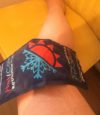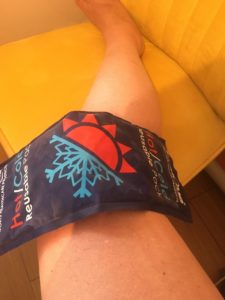hot or cold injury treatment

We are often asked in our daily sports and massage therapy treatments if hot or cold injury treatment and pain relief should be used. Here Lauren our Sports Therapist in Truro explores this question.
Cold therapy
Cold therapy is a commonly performed strategy for promoting recovery from musculoskeletal injuries, such as pulled muscles and any pain located in the joints. This makes it a great tool in sports injuries where acute injuries of soft tissues can occur.
Reduction of pain, inflammation and fatigue are all known to be benefits of cold therapy. The purpose of using cold therapy is to reduce the blood flow to the affected area, encouraging the reduction of pain and inflammation around muscles, joints, tendons and ligaments.
When the affected area is inflamed and causing an occurrence of pain, it is important to aim to control this first, to relieve pain and reduce inflammation within an injury or recovery scenario.

Avoid applying heat to any new injuries, as this is likely to aggravate the swelling to the affected area. The main physiological effects of cryotherapy are related to limiting the amount of blood to be pumped to the area (vasoconstriction) and limit the heat to disperse to the affected area. Cold therapy, such as ice is believed to help control pain by dealing with local inflammation around the affected area, as well as speeding up the recovery process to heal.
When to use cold therapy
People use Cold therapy when acute inflammation begins at the time of an injury and lasts for approximately 0-72 hours. If swelling still remains present after 72 hours, cold therapy may continue further until swelling has significantly disappeared. In addition, once the swelling has reduced significantly, the contrast bathing protocol can occur.
Cold packs are often used to reduce swelling in soft tissues as a first-aid measure by applying ice packs to the injured area (being sure not to apply ice directly to the skin as it will burn. As per the NHS website ice packs can be applied to the injury every 20 minutes for 2 -3 hours as a first-aid measure for sprains and strains.
Hot therapy
Hot therapy is a commonly used strategy used as a comfort to reduce pain from musculoskeletal injuries or any aches or pains. As previously mentioned, the purpose of hot therapy is to increase the blood flow into the targeted tissues, which helps to deliver required oxygen and nutrients and remove cell wastes. In doing so, the warmth decreases muscle spasm, relaxes tense muscles, relieves pain, and can increase range of motion. Applying Hot therapy after using cold therapy for around 72 hours or once the inflammation has cleared. It is important to note that you should not apply hot therapy to any open wounds.
Benefits of hot therapy
Hot therapy can also be used for comfort, relaxation and to take the edge off various pain-related conditions or pain-related issues that lead to stiffness, cramping and sensitivity. Heat treatment is often used for chronic pain. For example, osteoarthritis, fibromyalgia, neurological pain, rheumatic diseases or sleep deficiency.
People use Hot therapy for approximately 15-20 minutes for those with injuries or conditions. However, using for longer if necessary for those with more moderate to severe pain or discomfort is possible.
Contrast bathing
We use contrast bathing as a combination of cold and hot therapy to treat musculoskeletal injuries or any aches or pains. The aim of this strategy is to help reduce pain and muscle spasms, enhance the range of motion and strength.
Contrast bathing happens through a rapid change from hot to cold temperatures, helping to quickly open up and close the blood vessels within the body. Hot therapy will allow the blood vessels to expand (vasodilation), allowing more blood pumping through the body. In contrast, cold therapy allows the blood vessels to become smaller (vasoconstrict), limiting the amount of blood pumping to the area. The purpose of contrast bathing is to slow the blood circulation, which helps to reduce inflammation, muscle spasm, and pain. In addition, the purpose of hot therapy is to increase the blood flow into the targeted tissues, which helps to deliver required oxygen and nutrients and remove cell wastes.
There is contrary research towards the duration of contrast bathing although many research articles have actively supported its benefits. With the lack of clear guidance on what the ‘correct’ set up consists of please explore the many publications discussing the length of time of contrast bathing and its benefits. Please remember safety first and explore the evidence before deciding if it is right for you.
Hot or cold injury treatment ideas
Cold therapy:
- ice pack,
- cold shower/bath,
- bag of peas,
- deep freeze
Hot therapy:
- heat pack,
- warm bath,
- deep heat sprays and lotions
- warm water bottle
Many people ask whether cold or hot therapy is the best outcome for their musculoskeletal injuries/conditions. Here are some musculoskeletal areas, but are not limited to:
New injury:
New injuries to the muscualarskeltal system, including muscles, tendons, and ligaments, require cold therapy to reduce the inflammation in the first 0-72 hours of injury occurrence.
Conditions:
Conditions such as fibromyalgia, arthritis or general aches and pains often benefit from hot therapy, as a sense of comfort and pain relief.
Nerve pain:
Hot therapy usually responds really well to neurological pain. This often helps to relieve pain. For example, sciatic nerve, radiating down to the lower back, to the gluteal and down the leg.
When hot or cold therapy should not be used
- Diabetes (sensory changes)
- deep vein thrombosis
- dermatitis
- multiple sclerosis (MS)
- vascular diseases
Top Tips:
- Don’t burn yourself, always make sure the water is at a warm and safe temperature, always wrap in a towel.
- Be cautious of burns from cold water or ice packs, again always wrap in a towel.
- During contrast bathing, it is a good idea to finish with a cold therapy application, in case of any present swelling.
- Careful stretching or mobility can be performed during a hot therapy application. Due to the allowance of muscle elasticity of connective tissues.
- Do what works best for you, to control and manage your pain!
Disclaimer
The information in this blog does not constitute medical advice, always seek medical help if in any doubt.
You can book a Sports Therapy or Sports Massage session with Lauren here. Or to find out more email Lauren@keherentherapy.co.uk


